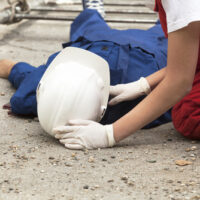Court Strips Away Most of Plaintiff’s New York Labor Law Construction Accident Claims, But Leaves Enough to Go to Trial

In the case of Gilmore v. Pavarini McGovern, the Supreme Court, New York County recently ruled on the defendants’ motions for summary judgment to dismiss the plaintiff’s personal injury claims arising out of a workplace accident at a New York City construction site. The accident occurred at a work site on Fifth Avenue in Manhattan, a few blocks south of 42nd Street. The plaintiff, a concrete carpenter, had stepped down from a scaffold and was moving to retrieve a piece of wood when he slipped/tripped on a burlap bag with a banana or bullnose inside, which was lying near the base of the scaffold. A banana or bullnose is a steel tool used in the erection of job site scaffolds.
The plaintiff brought claims against the property owner and the general contractor under common law negligence as well as New York Labor Law section 200 and section 241(6). The section 241(6) claims were based on four different provisions of the Industrial Code: 23-1.7(d), 23-1.7(e)(1), 23-1.7(e)(2) and 23-2.1(a). The defendants moved for summary judgment to dismiss all the claims, and the plaintiff only actively opposed the motion on the 23-1.7(e)(1) and (2) claims. The court therefore dismissed all the other claims against the defendants and then addressed the remaining 241(6) claims.
Section 241(6) requires contractors and owners to maintain the work site in a way that provides reasonable and adequate protection and safety to workers. To prevail on a 241(6) claim, the plaintiff must establish a violation of an applicable provision of the Industrial Code which sets forth a specific standard of conduct, namely a relevant and specific safety provision from part 23 of the code which is applicable to the facts of the case.
Here the plaintiff alleged violations of 23-1.7(e)(1) and (2):
(e)(1) Passageways. All passageways shall be kept free from accumulations of dirt and debris and from any other obstructions or conditions which could cause tripping. Sharp projections which could cut or puncture any person shall be removed or covered.
(e)(2) Working areas. The parts of floors, platforms and similar areas where persons work or pass shall be kept free from accumulations of dirt and debris and from scattered tools and materials and from sharp projections insofar as may be consistent with the work being performed.
The court held that the defendants did not demonstrate that there were no triable issues of fact regarding whether the accident occurred in a passageway or working area, and whether the bullnose or banana and burlap bag were there because they were an integral part of the work at the time or whether they were “obstructions” or “scattered tools and materials.” The court therefore denied the defendants’ motions for summary judgment on those grounds, leaving the case alive to proceed and giving the plaintiff the opportunity to establish liability for this construction site accident.


